Why Normal Maintenance Can Decrease Future Dock Repairs
Why Normal Maintenance Can Decrease Future Dock Repairs
Blog Article
Effective Dock Repair Work Techniques: Making Sure Structural Honesty
Making sure the structural stability of docks with effective repair service techniques is extremely important for the durability and safety of aquatic centers. Consequently, picking the best repair materials, such as corrosion-resistant alloys and composite materials, is essential for durability.
Examining Dock Damage
Analyzing dock damage is a critical initial step in making certain the architectural integrity and safety and security of any docking center. This initial assessment entails a comprehensive assessment to identify both surprise and noticeable problems. Key elements to take a look at consist of the dock's foundation, pilings, decking, and hardware. Each element has to be inspected for indications of wear, rot, deterioration, or various other forms of deterioration that can compromise the structural integrity.
Architectural designers or certified assessors typically perform these evaluations making use of specialized strategies and devices. Underwater assessments may use finder equipment or from another location ran lorries (ROVs) to detect submerged damage. Above water, aesthetic evaluations are enhanced by utilizing wetness meters and various other analysis devices to reveal underlying concerns not right away visible to the nude eye.

Picking Repair Service Products
Selecting the suitable repair service products is a pivotal action in the dock repair procedure, one that straight affects the long life and performance of the repaired structure. Material selection should be driven by aspects such as ecological problems, load-bearing needs, and compatibility with existing dock parts. Wood is a conventional choice for docks due to its natural resilience and visual allure. Selecting the right kind of timber, such as pressure-treated lumber or normally rot-resistant types like cedar or teak, is essential to withstand marine settings.
Along with wood, composite materials are increasingly preferred because of their durability and reduced maintenance requirements. Compounds, normally made from a blend of plastic and timber fibers, use exceptional resistance to rot, bugs, and UV damage. For steel anchors, choosing corrosion-resistant alloys such as galvanized steel or marine-grade light weight aluminum is necessary to protect against corrosion and guarantee structural integrity in saline water problems.
Epoxy resins and marine-grade sealants are indispensable for fixing fractures and sealing joints, giving a water-proof barrier and boosting the dock's general stamina. By thoroughly picking high-grade materials, dock repair work can attain lasting outcomes, consequently guarding against future destruction and guaranteeing risk-free, trusted use.
Architectural Support Techniques
Efficient structural reinforcement strategies are essential in ensuring the security and longevity of dock fixings. One basic approach entails the use of steel or composite reinforcement bars (rebar) within concrete frameworks. Rebar provides extra tensile stamina, preventing fractures and distributing lots extra equally. This method is especially reliable for docks exposed to hefty lots or severe environmental problems.
One more essential method is the application of fiber-reinforced polymers (FRP) These materials use high strength-to-weight proportions and superb resistance to rust, making them ideal for strengthening wooden or concrete anchors. FRP can be used in sheets or strips and adhered with epoxy resins to boost architectural honesty.
Supporting and securing systems likewise play an important duty in architectural support. Cross-bracing, utilizing metal or wood light beams, can counteract side pressures, reducing persuading and activity. Anchoring systems, such as helical piers or driven stacks, supply a secure structure by moving tons to much deeper, much more secure dirt layers.
Last but not least, the combination of load-distribution plates can aid distribute weight a lot more evenly throughout the dock's surface area, reducing localized tension factors. These strategies jointly guarantee that docks remain durable and safe, qualified of standing up to the rigors of their operational setting.
Advanced Repair Work Techniques

Another innovative technique involves underwater welding, which permits repair work to be performed without the requirement to dewater the location. This approach is particularly advantageous for dealing with structural issues in submerged dock components, ensuring very little disruption to procedures. Boosted welding techniques, coupled with robot systems, supply precision and reliability, thereby prolonging the life expectancy of the dock.
In addition, cathodic protection systems are applied to stop corrosion in metal dock frameworks. By utilizing sacrificial anodes or impressed present systems, these strategies successfully minimize the electrochemical processes that bring about material deterioration.
Finally, advanced surveillance innovations, such as architectural health surveillance (SHM) systems, supply real-time data on the problem of dock structures. These systems make it possible for proactive upkeep and timely interventions, inevitably ensuring the long-term structural integrity of the dock.
Maintenance and Avoidance
Maintenance and prevention are fundamental ideas that underpin the durability and safety and security of dock frameworks. Regular assessments are vital, allowing for very early detection of damage, potential weaknesses, and environmental influences. An aggressive method, entailing routine checks for corrosion, rot, and architectural changes, reduces expensive repair work and prolongs the dock's operational life.
Precautionary actions must include applying safety this finishes to steel elements to defend against corrosion and using treated timber to withstand degeneration. Furthermore, making certain correct drainage and air flow can protect against water buildup, which is an usual source of structural deterioration. Incorporating high quality products and sticking to producer standards during building and repair work stages additionally play vital functions in enhancing toughness.

Educating personnel in dock upkeep best practices makes certain regular application of safety nets. Leveraging technological advances, such as drones for assessments and sensing units for real-time surveillance, can additionally enhance upkeep efforts. By focusing on maintenance and avoidance, dock owners can make sure structural honesty, operational security, and cost-effective administration over the dock's life-span.
Conclusion
In final thought, keeping the structural stability of marine facilities requires detailed dock repair methods. Advanced fixing methods, coupled with normal upkeep practices, make sure the dock continues to be secure and operational under diverse ecological problems.
Making certain the structural stability of anchors through effective repair work strategies is critical for the durability and safety and security of aquatic facilities.Selecting the appropriate repair service materials is a pivotal step in the dock restoration process, one that directly influences the durability and efficiency of the click now repaired structure.Reliable structural support techniques are essential in making sure the security and long life of dock fixings. By prioritizing maintenance and prevention, dock owners can ensure architectural stability, operational safety, and affordable management over the dock's lifespan.
In final thought, maintaining the structural stability of aquatic facilities necessitates detailed learn the facts here now dock repair methods.
Report this page